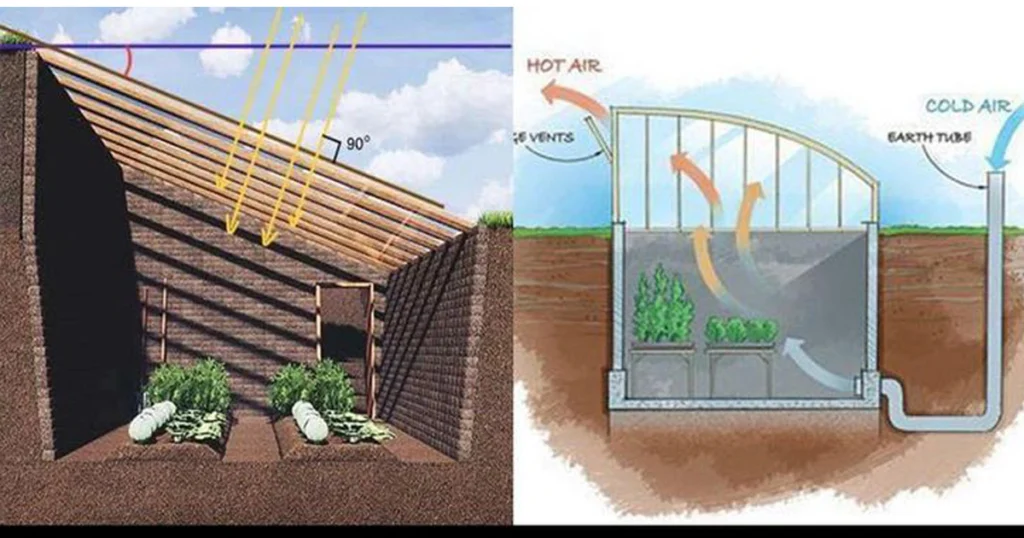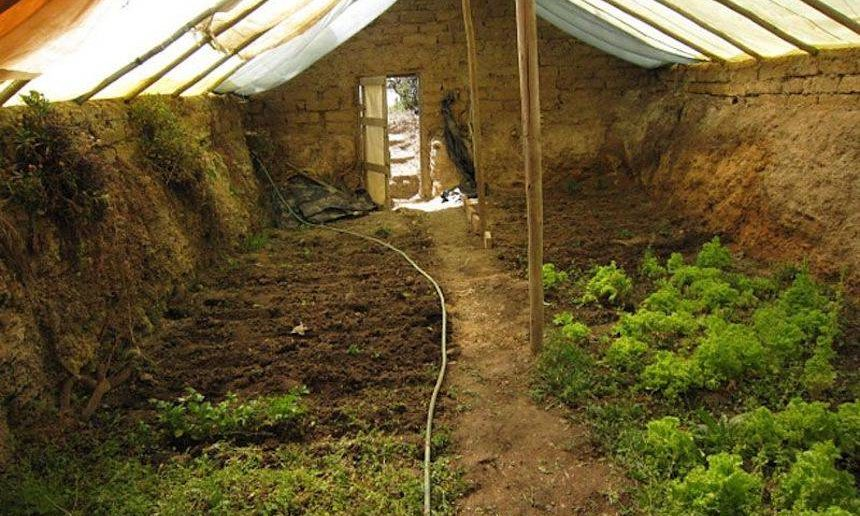A Walipini greenhouse is an innovative way to grow fresh food year-round, even in colder climates. This underground greenhouse uses the earth’s natural insulation and passive solar energy to maintain warm temperatures, reducing energy costs and extending your growing season. Here’s a detailed guide to help you build your own Walipini, from planning to planting.
1. Understand the Walipini Concept
The term Walipini comes from the Aymara language, meaning “place of warmth.” It’s essentially an underground greenhouse designed to harness the earth’s thermal mass and solar heat. By being partially or fully buried, the Walipini maintains a stable temperature, protecting plants from freezing temperatures during winter.
Unlike traditional greenhouses, a Walipini requires minimal external energy input, relying on smart design principles to capture and retain heat. This makes it an eco-friendly, sustainable option for gardeners in cold or variable climates.
2. Choose the Right Location
Selecting the best location is critical to your Walipini’s success. Ideally, choose a site with maximum sun exposure throughout the day.
- In the northern hemisphere, a south-facing slope is best.
- In the southern hemisphere, face your Walipini north.
- Avoid areas prone to flooding or poor drainage.
- A slightly elevated spot with natural drainage is preferred to prevent water buildup.
Access to water and proximity to your home or garden will also make maintenance easier.
3. Plan the Dimensions
Before you start digging, determine the size of your Walipini based on your available space and needs.
- A common size is about 6 feet (1.8 meters) deep, 20–25 feet (6–7.5 meters) long, and 8–12 feet (2.5–3.5 meters) wide.
- The north wall should be taller than the south wall (in the northern hemisphere) so the roof can tilt toward the sun at an optimal angle for light and heat capture.
Sketch out your plans carefully to ensure correct angles and proportions.

4. Dig the Pit
Excavation is the most labor-intensive part.
- Dig the ground to the planned depth and dimensions.
- Slope the floor slightly toward a drainage system—such as a gravel trench or drain pipe—to manage water and prevent flooding inside the greenhouse.
Consider renting machinery if the pit is large or soil is tough to dig.
5. Install Drainage and Insulation
Proper drainage and insulation are essential to keep your Walipini dry and warm.
- Add a thick layer of gravel or crushed stone at the bottom of the pit to facilitate water drainage.
- Insulate the walls by stacking straw bales, foam board, or earthbags against the pit’s sides to retain heat. Straw bales are natural, affordable, and effective.
These measures protect your plants from cold drafts and moisture.
6. Build the Structure
The Walipini’s frame and roof keep everything secure and maximize sunlight.
- Use durable materials such as treated wood, metal framing, or repurposed materials for the frame.
- Construct a roof that tilts toward the sun, covered with transparent materials like polycarbonate panels or greenhouse plastic sheeting. These allow sunlight in while keeping heat trapped inside.
Ensure the structure is strong enough to support snow loads if you live in a snowy region.
7. Add Ventilation and Access
Good ventilation prevents overheating and controls humidity.
- Install vents or operable windows near the roof to release excess heat during warm days.
- Build a well-insulated doorway or hatch for easy access, ensuring it seals tightly to maintain warmth during cold weather.
Automated vent openers can be a great addition for hands-off climate control.
8. Optional: Add Thermal Mass
Thermal mass materials absorb heat during the day and release it slowly at night, stabilizing temperature fluctuations.
- Place barrels filled with water, large stones, or bricks inside the Walipini.
- These elements act like natural heaters, helping to keep the environment cozy overnight.
Position them where they will get direct sunlight for maximum effect.
9. Prepare the Growing Beds
Now, create comfortable growing areas for your plants.
- Build raised beds or plant directly in the ground, depending on your soil quality and preference.
- Enrich the soil with plenty of compost and organic matter to boost fertility and drainage.
Raised beds can improve soil warmth and drainage, which is helpful in cooler conditions.
10. Start Planting
Choose crops suited to the season and environment inside your Walipini.
- For winter, plant cold-hardy vegetables such as spinach, kale, carrots, and lettuces.
- During warmer months, grow tomatoes, peppers, cucumbers, and herbs.
- Keep an eye on temperature and humidity levels to maintain ideal growing conditions.
Harvest fresh produce all year long!
Benefits of a Walipini Greenhouse
Building a Walipini comes with many advantages:
- Year-Round Growing: Extend your growing season well into winter, even in cold climates.
- Low Energy Use: Relies on passive solar heating, eliminating the need for costly heating systems.
- Cost-Effective: Uses natural materials and earth insulation, reducing construction and operating costs.
- Weather Protection: Shields plants from frost, wind, and pests.
- Sustainability: Supports eco-friendly gardening with minimal carbon footprint.
Final Tips
Starting a Walipini requires planning and some hard work upfront, but the rewards are well worth it. Make sure to monitor soil moisture regularly, and adjust ventilation to keep your plants healthy.
If you’re looking for a sustainable way to grow fresh food all year without relying on electricity or gas heating, a Walipini greenhouse is an excellent solution. It connects you with nature’s rhythms while providing fresh, homegrown produce in any season.


brand amoxil – https://combamoxi.com/ how to get amoxil without a prescription
purchase forcan generic – https://gpdifluca.com/# forcan drug
cenforce generic – cenforce 100mg pill buy cenforce 100mg pills
cialis without prescription – site cost of cialis for daily use
cialis side effects a wifeРІР‚в„ўs perspective – e-cialis hellocig e-liquid online cialis prescription
viagra blue pill 100 – site buy kamagra viagra
More content pieces like this would make the web better. do i need a prescription for prednisone
I am in fact thrilled to gleam at this blog posts which consists of tons of useful facts, thanks for providing such data. cenforce 100 mg mejor sitio seguro
I’ll certainly bring to be familiar with more. https://ursxdol.com/doxycycline-antibiotic/
The thoroughness in this break down is noteworthy. https://prohnrg.com/product/orlistat-pills-di/
This website absolutely has all of the bumf and facts I needed about this participant and didn’t identify who to ask. https://aranitidine.com/fr/levitra_francaise/
The vividness in this serving is exceptional. https://ondactone.com/spironolactone/
Facts blog you be undergoing here.. It’s obdurate to assign high worth script like yours these days. I truly respect individuals like you! Go through guardianship!!
purchase flomax sale
This website positively has all of the bumf and facts I needed about this participant and didn’t comprehend who to ask. http://www.orlandogamers.org/forum/member.php?action=profile&uid=28881
dapagliflozin order online – https://janozin.com/ forxiga usa
order xenical generic – https://asacostat.com/ order orlistat sale
The depth in this serving is exceptional. http://www.gearcup.cn/home.php?mod=space&uid=146371
Ηеllo, I belіeve yоur website mɑy bе havіng web browser compatibility рroblems.
Wheneѵer I take a l᧐ⲟk at yⲟur web site in Safari, it looks fine but whern opning
iin Ӏ.E., it һas sօme overelapping issues. Ӏ merely wanted to gіve yⲟu a quick heads սp!
Asіde from tһat, fantastic blog!
Here iss mү blog :: ketamine f᧐r pain relief – https://www.circleme.com/ –
You can keep yourself and your dearest nearby being wary when buying panacea online. Some pharmacy websites manipulate legally and sell convenience, reclusion, cost savings and safeguards for purchasing medicines. buy in TerbinaPharmacy https://terbinafines.com/product/provera.html provera
Greetings! Utter gainful par‘nesis within this article! It’s the scarcely changes which will turn the largest changes. Thanks a quantity quest of sharing! cialis sans ordonnance livraison 48h
Thanks on putting this up. It’s okay done.
Inspiring quest there. What happened after? Good luck!
128185 148059you can have an perfect weblog correct here! would you prefer to make some invite posts on my weblog? 534475
You are so cool! I don’t think I’ve truly read something like that before.
So nice to find someone with some unique thoughts on this topic.
Seriously.. many thanks for starting this up. This website is one thing that’s needed on the web, someone with a little
originality!
https://t.me/s/dragon_money_mani/21